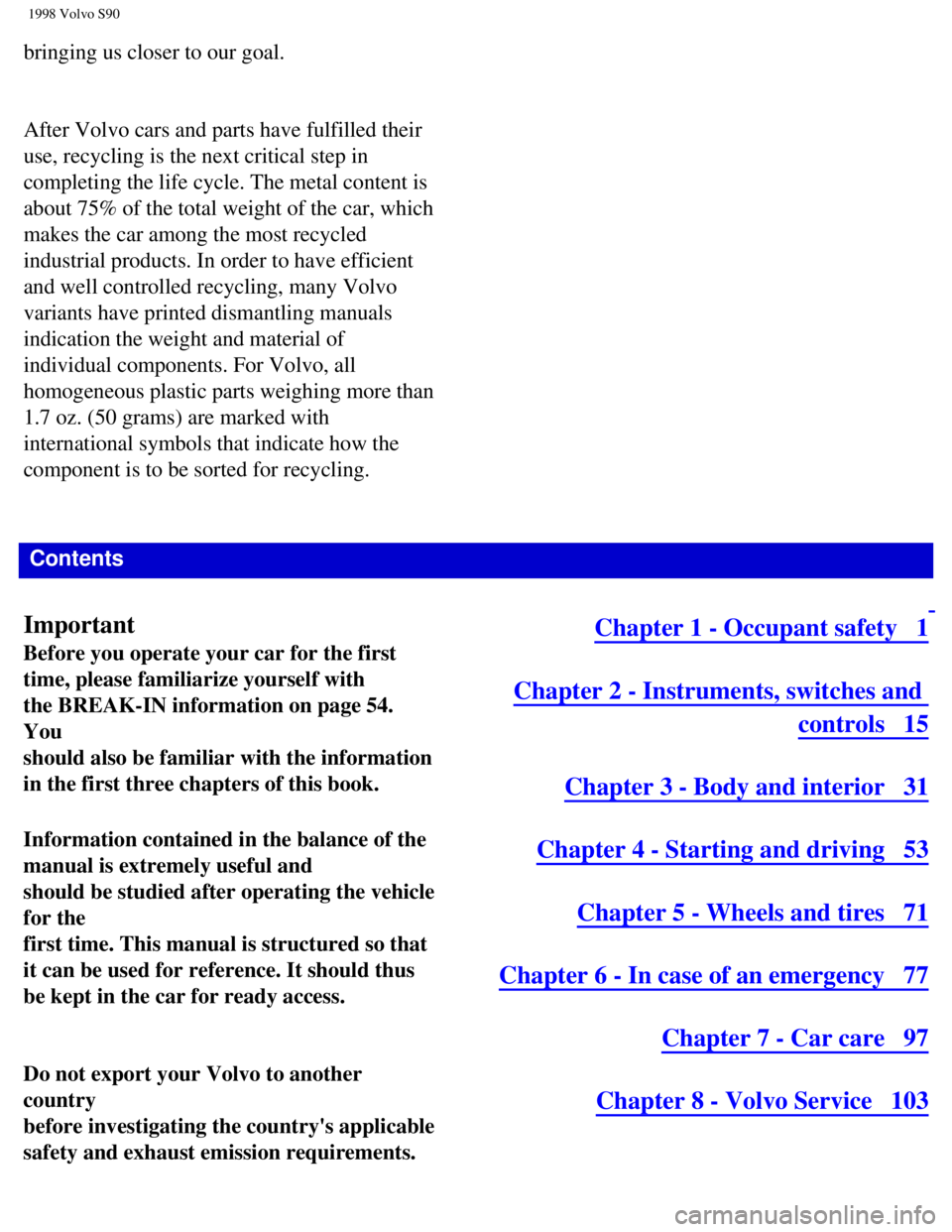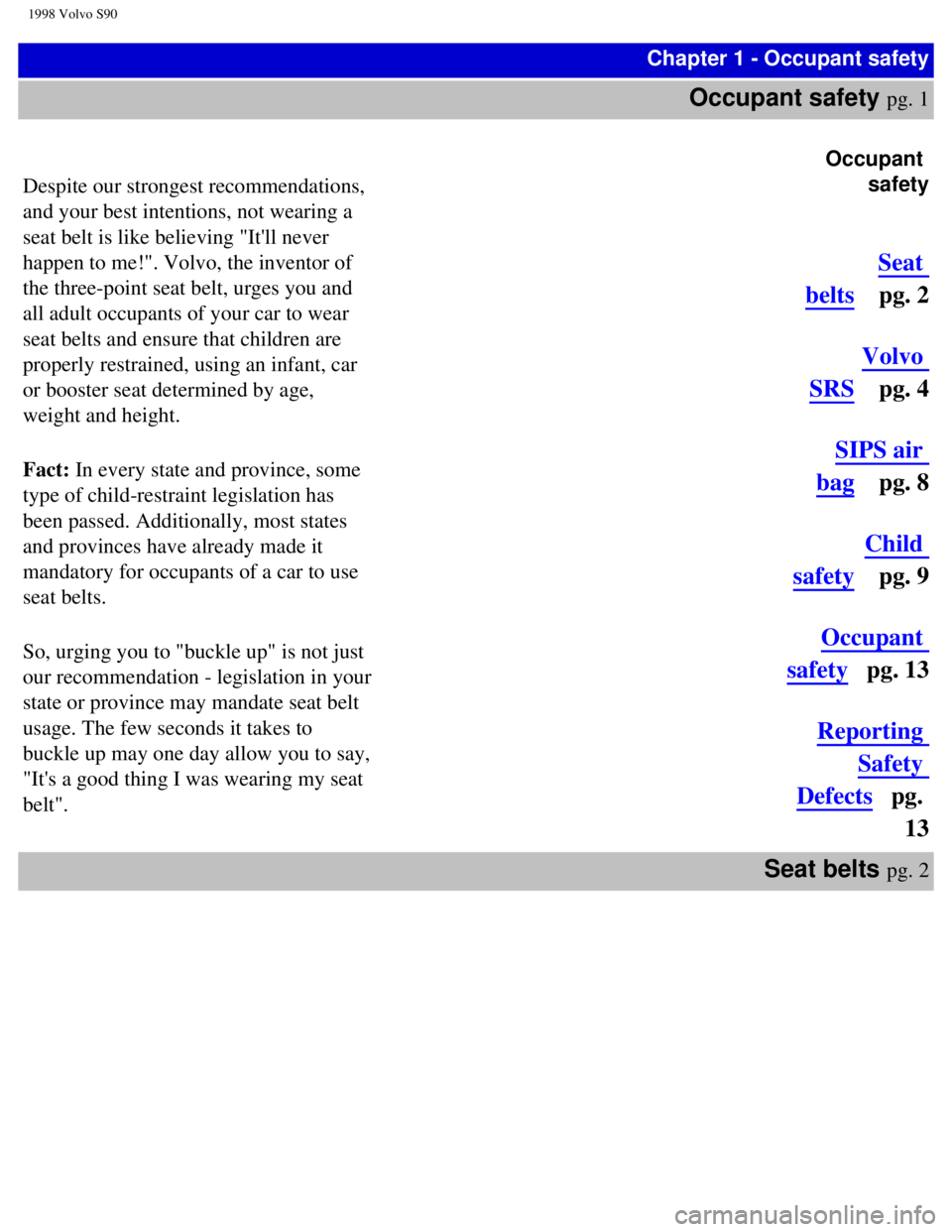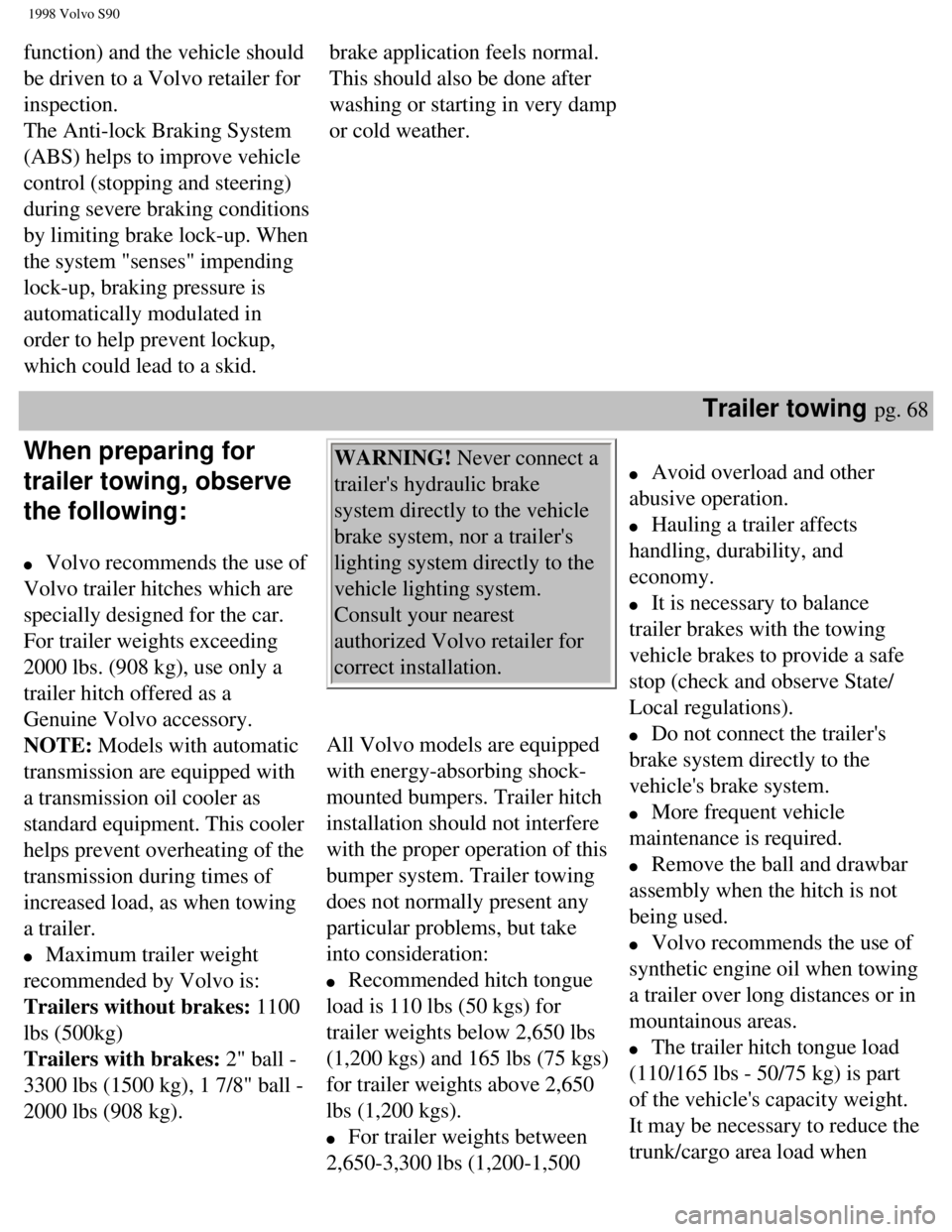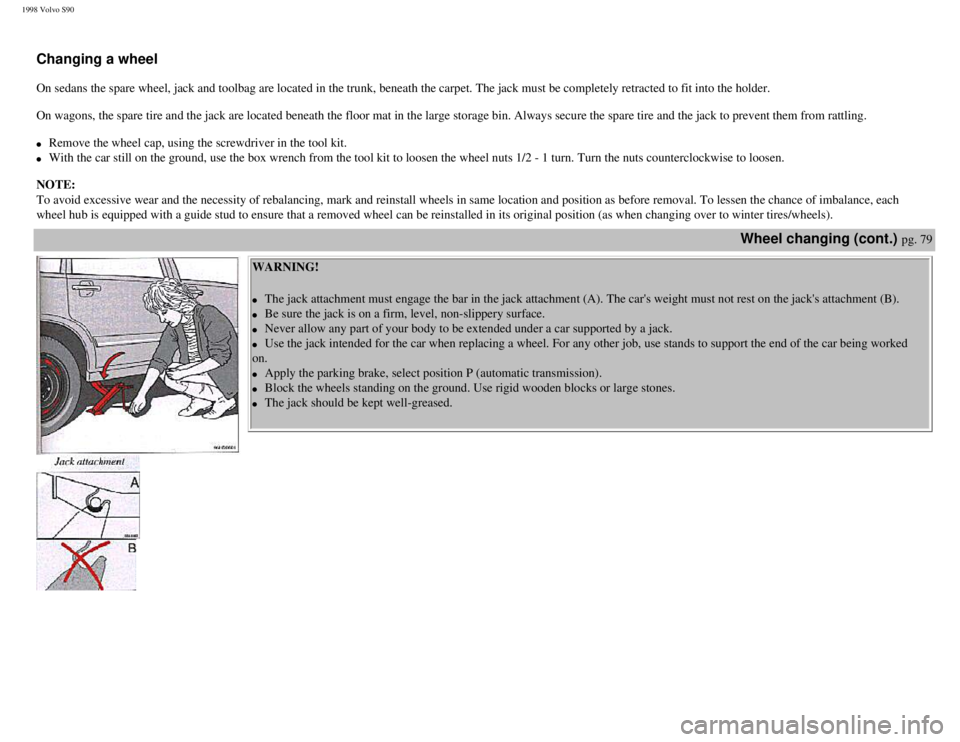1998 VOLVO V90 weight
[x] Cancel search: weightPage 3 of 175

1998 Volvo S90
bringing us closer to our goal.
After Volvo cars and parts have fulfilled their
use, recycling is the next critical step in
completing the life cycle. The metal content is
about 75% of the total weight of the car, which
makes the car among the most recycled
industrial products. In order to have efficient
and well controlled recycling, many Volvo
variants have printed dismantling manuals
indication the weight and material of
individual components. For Volvo, all
homogeneous plastic parts weighing more than
1.7 oz. (50 grams) are marked with
international symbols that indicate how the
component is to be sorted for recycling.
Contents
Important
Before you operate your car for the first
time, please familiarize yourself with
the BREAK-IN information on page 54.
You
should also be familiar with the information
in the first three chapters of this book.
Information contained in the balance of the
manual is extremely useful and
should be studied after operating the vehicle
for the
first time. This manual is structured so that
it can be used for reference. It should thus
be kept in the car for ready access.
Do not export your Volvo to another
country
before investigating the country's applicable
safety and exhaust emission requirements.
Chapter 1 - Occupant safety 1
Chapter 2 - Instruments, switches and
controls 15
Chapter 3 - Body and interior 31
Chapter 4 - Starting and driving 53
Chapter 5 - Wheels and tires 71
Chapter 6 - In case of an emergency 77
Chapter 7 - Car care 97
Chapter 8 - Volvo Service 103
file:///K|/ownersdocs/1998/1998_SV90/98S90_000.htm (3 of 4)12/30/2006 \
1:52:33 PM
Page 5 of 175

1998 Volvo S90
Chapter 1 - Occupant safety
Occupant safety pg. 1
Despite our strongest recommendations,
and your best intentions, not wearing a
seat belt is like believing "It'll never
happen to me!". Volvo, the inventor of
the three-point seat belt, urges you and
all adult occupants of your car to wear
seat belts and ensure that children are
properly restrained, using an infant, car
or booster seat determined by age,
weight and height.
Fact: In every state and province, some
type of child-restraint legislation has
been passed. Additionally, most states
and provinces have already made it
mandatory for occupants of a car to use
seat belts.
So, urging you to "buckle up" is not just
our recommendation - legislation in your
state or province may mandate seat belt
usage. The few seconds it takes to
buckle up may one day allow you to say,
"It's a good thing I was wearing my seat
belt".
Occupant
safety
Seat
belts pg. 2
Volvo
SRS pg. 4
SIPS air
bag pg. 8
Child
safety pg. 9
Occupant
safety pg. 13
Reporting
Safety
Defects pg. 13
Seat belts
pg. 2
file:///K|/ownersdocs/1998/1998_SV90/98S90_001.htm (1 of 5)12/30/2006 \
1:52:33 PM
Page 20 of 175

1998 Volvo S90
are used properly. However, children
could be endangered in a crash if the
child restraints are not properly secured
in the vehicle. Failure to follow the
installation instructions for your child
restraint can result in your child striking
the vehicle's interior in a sudden stop.
Holding a child in your arms is NOT a
suitable substitute for a child restraint
system. In an accident, a child held in a
person's arms can be crushed between
the vehicle's interior and an unrestrained
person. The child could also be injured
by striking the interior, or by being
ejected from the vehicle during a sudden
maneuver or impact. The same can also
happen if the infant or child rides
unrestrained on the seat. Other
occupants should also be properly
restrained to help reduce the chance of
injuring or increasing the injury of a
child. All states and provinces have
legislation governing how and where
children should be carried in a car. Find
out the regulations existing in your state
or province. l Make sure the child restraint
system is approved for the child's
height, weight and development -
the label required by the standard
or regulation, or instructions for
infant restraints, typically provide
this information.
l In using any child restraint
system, we urge you to look
carefully over the instructions
that are provided with the
restraint. Be sure you
understand them and can use
the device properly and safely
in this vehicle. A misused child
restraint system can result in
increased injuries for both the
infant or child and other
occupants in the vehicle.
l If your child restraint requires a
top tether strap, consult your
authorized Volvo retailer for top
tether anchorage and installation
information.
is available for use in the luggage
compartment of station wagon models.
This seat is designed for two children,
each weighing between 23 - 40 kg (50 -
88 lbs.) and up to 150 cm (59 inches) in
height.
WARNING!
l When using the auxiliary seat
for children, both sections of
the rear seat backrest must be
secured in the upright position
l Do not use a booster cushion or
child seat in conjunction with
the auxiliary seat.
Occupant Safety pg. 13
Seat belt maintenance
Check periodically that the anchor bolts
are secure and that the belts are in good
condition. Use water and a mild
detergent for cleaning. Check seat belt
mechanism function as follows: Attach
the seat belt and pull rapidly on the strap.
Volvo Concern for Safety
Safety is the cornerstone for Volvo. Our
concern dates back to 1927 when the
first Volvo rolled off the production line.
Three-point seat belts (a Volvo
invention), safety cages, and energy-
absorbing impact zones were designed
into Volvo cars long before it was
fashionable or required by government
regulation. We will not compromise our
commitment to safety. We continue to
seek out new safety features and to refine
those already in our cars. You can help.
We would appreciate hearing your
suggestions about improving automobile
Occupant safety
How safely you drive doesn't depend on
how old you are but rather on:
l how well you see
l your ability to concentrate
l how quickly you make decisions
under stress to avoid an accident.
The tips listed below are
suggestions to help you cope with
the ever changing traffic
environment.
l Never drink and drive.
l If you are taking any medication,
consult your physician about its
potential effects on your driving
abilities.
l Take a driver-retraining course
l Have your eyes checked regularly
l Keep your windshield and
headlamps clean.
l Replace wiper blades when they
start to leave streaks.
l Take into account the traffic,
Reporting Safety Defects in
the U.S.
If you believe that your vehicle has a
defect which could cause a crash or
could cause injury or death, you
should immediately inform the
National Highway Traffic Safety
Administration (NHTSA) in
addition to notifying Volvo Cars of
North America. If NHTSA receives
similar complaints, it may open an
investigation, and if it finds that a
safety defect exists in a group of
vehicles, it may order a recall and
remedy campaign. However,
NHTSA cannot become involved in
individual problems between you,
your retailer, or Volvo Cars of North
America. To contact NHTSA, you
may either call the Auto Safety
Hotline toll-free at 1-800-424-9393
file:///K|/ownersdocs/1998/1998_SV90/98S90_009.htm (4 of 5)12/30/2006 \
1:52:35 PM
Page 57 of 175

1998 Volvo S90
l To slide open the sun roof :
press the lower section of the
switch.
l To close the sun roof :press
the upper section of the
switch until the sun roof has
closed completely .
l To open the rear edge of
the sun roof (ventilation
position): press the upper
section of the switch. Press
the lower section of the
switch to return the sun roof
to the closed position.
with the sun roof when the sun roof slides
back (not when the sun roof is opened to
the ventilation position).
l The sun shade can also be opened
manually even if the sun roof is closed.
l The sun shade will not close
automatically with the sun roof. It must be
closed manually.
WARNING! (SUN ROOF): The sun
roof must never be obstructed in any
way when in operation.
an overload protecting circuit breaker
(fuse no. 26) which is activated when an
object blocks the sun roof. Should this
occur, remove the object and wait 20
seconds for the circuit breaker to reset.
The sun roof should then function
normally.
l To help alleviate "rumbling" wind
noise when the sun roof is open, adjust the
position slightly (open/close).
Long load storage (sedan) pg. 50
Long load storage
In the panel behind the rear seat is a door
which makes it possible to carry long
loads such as skis, etc.
WARNING!
Cover sharp edges on load to help
prevent injury to occupants. Secure
load to help prevent shifting during
sudden stops.
Protective covers (for skis) should
also be used to avoid soiling or
tearing the upholstery. Please note
that the flap in the rear seat is only
intended for light loads such as skis,
carpets, etc.
Max. length of load 6 1/2 ft = 2m.
Max. weight of load 33 lbs = 15 kg.
file:///K|/ownersdocs/1998/1998_SV90/98S90_048.htm (2 of 4)12/30/2006 \
1:52:40 PM
Page 71 of 175

1998 Volvo S90
disconnected, the code must
be re-entered before the radio
will function properly.
Points to remember pg. 62
Weight distribution affects
handling
At the specified curb weight
your car has a tendency to
understeer, which means that the
steering wheel has to be turned
more than might seem
appropriate for the curvature of
a bend. This ensures good
stability and reduces the risk of
rear wheel skid. Remember that
these properties can alter with
the vehicle load. The heavier the
load in the trunk, the less the
tendency to understeer.
Handling, roadholding
Vehicle load, tire design, and
inflation pressure, all affect
vehicle handling. Therefore,
check that the tires are inflated
to the recommended pressure
according to the vehicle load.
See "Tire pressure" section.
Loads should be distributed so
that capacity weight or
maximum permissible axle loads
are not exceeded.
WARNING!
An extra mat on the driver's
floor can cause the
accelerator pedal to catch.
Check that the movement of
the accelerator pedal is not
impeded. Not more than one
protective floor covering may
be used at one time.
CAUTION: Drive slowly and
carefully if going through
standing water (i.e. flooded
roadways, etc.). Damage to
engine could result if excess
water is ingested through the air
intake system. Never drive the
vehicle in water deeper than 1
foot (300 mm). See the flood
warning on page 7.
WARNING! Do not drive
with trunk lid or tailgate
open!
Poisonous exhaust gases may
enter via the trunk lid or
tailgate.
If the trunk lid/tailgate must
be kept open for any reason,
proceed as follows:
l Close the windows.
l Set the ventilation system
Roof rails/racks
Roof rails are standard
equipment on wagon models.
Load bars are available as a
retailer installed option on the
sedan models. Observe the
following points when is use:
l Avoid single-point loads.
Distribute the load evenly.
l Place heavier cargo at bottom
of load.
l Observe that center of gravity
and handling are influenced by
load weight.
l Increasing load size increases
wind resistance and, thus,
adversely affects fuel economy.
l Anchor the cargo correctly
with appropriate tie-down
equipment.
l Drive carefully. Avoid rapid
starts, fast cornering and hard
braking.
l Max. roof load is 220 lbs.
(100 kg) for removable racks.
For permanent roof racks, check
the manufacturers weight
specifications.
file:///K|/ownersdocs/1998/1998_SV90/98S90_058.htm (6 of 7)12/30/2006 \
1:52:42 PM
Page 78 of 175

1998 Volvo S90
function) and the vehicle should
be driven to a Volvo retailer for
inspection.
The Anti-lock Braking System
(ABS) helps to improve vehicle
control (stopping and steering)
during severe braking conditions
by limiting brake lock-up. When
the system "senses" impending
lock-up, braking pressure is
automatically modulated in
order to help prevent lockup,
which could lead to a skid. brake application feels normal.
This should also be done after
washing or starting in very damp
or cold weather.
Trailer towing pg. 68
When preparing for
trailer towing, observe
the following:
l Volvo recommends the use of
Volvo trailer hitches which are
specially designed for the car.
For trailer weights exceeding
2000 lbs. (908 kg), use only a
trailer hitch offered as a
Genuine Volvo accessory.
NOTE: Models with automatic
transmission are equipped with
a transmission oil cooler as
standard equipment. This cooler
helps prevent overheating of the
transmission during times of
increased load, as when towing
a trailer.
l Maximum trailer weight
recommended by Volvo is:
Trailers without brakes: 1100
lbs (500kg)
Trailers with brakes: 2" ball -
3300 lbs (1500 kg), 1 7/8" ball -
2000 lbs (908 kg).
WARNING! Never connect a
trailer's hydraulic brake
system directly to the vehicle
brake system, nor a trailer's
lighting system directly to the
vehicle lighting system.
Consult your nearest
authorized Volvo retailer for
correct installation.
All Volvo models are equipped
with energy-absorbing shock-
mounted bumpers. Trailer hitch
installation should not interfere
with the proper operation of this
bumper system. Trailer towing
does not normally present any
particular problems, but take
into consideration:
l Recommended hitch tongue
load is 110 lbs (50 kgs) for
trailer weights below 2,650 lbs
(1,200 kgs) and 165 lbs (75 kgs)
for trailer weights above 2,650
lbs (1,200 kgs).
l For trailer weights between
2,650-3,300 lbs (1,200-1,500
l Avoid overload and other
abusive operation.
l Hauling a trailer affects
handling, durability, and
economy.
l It is necessary to balance
trailer brakes with the towing
vehicle brakes to provide a safe
stop (check and observe State/
Local regulations).
l Do not connect the trailer's
brake system directly to the
vehicle's brake system.
l More frequent vehicle
maintenance is required.
l Remove the ball and drawbar
assembly when the hitch is not
being used.
l Volvo recommends the use of
synthetic engine oil when towing
a trailer over long distances or in
mountainous areas.
l The trailer hitch tongue load
(110/165 lbs - 50/75 kg) is part
of the vehicle's capacity weight.
It may be necessary to reduce the
trunk/cargo area load when
file:///K|/ownersdocs/1998/1998_SV90/98S90_067.htm (2 of 5)12/30/2006 \
1:52:43 PM
Page 79 of 175

1998 Volvo S90
Observe legal requirements of
the state in which the vehicles
are registered.
WARNING! Bumper-
attached trailer hitches must
not be used on Volvos, nor
should safety chains be
attached to the bumper.
Trailer hitches attaching to
the vehicle rear axle must
not be used. kgs) a top speed of 50 mph (80
km/h) should never be
exceeded.
l Increase tire pressure to
recommended full-load
pressure. See section "Wheels
and tires".
l Engine and transmission are
subject to increased loads.
Therefore, engine coolant
temperature should be closely
watched when driving in hot
climates or hilly terrain. Use
lower gear and turn off air
conditioner if temperature gauge
pointer enters the red range.
towing a trailer to ensure that the
max. permissible axle load or
gross vehicle weight are not
exceeded.
NOTE: Refer to section
"Automatic transmission" for
additional trailer hauling tips.
Winter driving pg. 69
Cold weather precautions
l If you wish to check your car before the
approach of cold weather, the following advice is
worth noting:
Make sure that the engine coolant contains at least
50 percent antifreeze: that is, 5.3 qts. (5 liters)
Volvo Genuine Coolant/Antifreeze. This gives
protection against freezing down to -31°F (-35°
C). See section "Coolant".
The use of "recycled" antifreeze is not approved
by Volvo. Different types of antifreeze may not be
mixed.
l Try to keep the fuel tank well filled - this
prevents the formation of condensation in the
tank.
In addition in extremely cold weather conditions it
is worthwhile to add fuel line de-icer before
refueling.
l The viscosity of the engine oil is important. Oil
with low viscosity (thinner oil) improves cold-
weather starting as well as decreasing fuel
consumption while the engine is warming up. For
winter use, 5W-30 oil, particularly the synthetic
type, is recommended.
Be sure to use good quality oil but do not use this
l The Volvo Washer Solvent should be diluted as
follows:
Down to 14°F (-10°C): 1 part anti-freeze and 4
parts water
Down to 5°F (-15°C): 1 part anti-freeze and 3
parts water
Down to 0°F (-18°C): 1 part anti-freeze and 2
parts water
Down to -18°F (-28°): 1 part anti-freeze and 1
part water
l Use lock spray or grease in the locks.
NOTE: Avoid the use of de-icing spray as they
can cause damage to the locks.
Automatic differential lock (certain
models)
The differential automatically locks at speed
between 3 - 25 mph (5 - 40 km/h) if either of the
drive wheels begins to lose traction. The
differential lock improves power distribution to
the drive wheels in slippery conditions, shifting
power to the wheel with best traction. It also
file:///K|/ownersdocs/1998/1998_SV90/98S90_067.htm (3 of 5)12/30/2006 \
1:52:43 PM
Page 88 of 175

1998 Volvo S90
Changing a wheel
On sedans the spare wheel, jack and toolbag are located in the trunk, be\
neath the carpet. The jack must be completely retracted to fit into the holder.
On wagons, the spare tire and the jack are located beneath the floor mat\
in the large storage bin. Always secure the spare tire and the jack to prevent them from rattling.
l Remove the wheel cap, using the screwdriver in the tool kit.
l With the car still on the ground, use the box wrench from the tool kit t\
o loosen the wheel nuts 1/2 - 1 turn. Turn the nuts counterclockwise to loosen.
NOTE:
To avoid excessive wear and the necessity of rebalancing, mark and reins\
tall wheels in same location and position as before removal. To lessen the chance of imbalance, each
wheel hub is equipped with a guide stud to ensure that a removed wheel c\
an be reinstalled in its original position (as when changing over to winter tires/wheels).
Wheel changing (cont.) pg. 79
WARNING!
l The jack attachment must engage the bar in the jack attachment (A). Th\
e car's weight must not rest on the jack's attachment (B).
l Be sure the jack is on a firm, level, non-slippery surface.
l Never allow any part of your body to be extended under a car supported b\
y a jack.
l Use the jack intended for the car when replacing a wheel. For any other \
job, use stands to support the end of the car being worked
on.
l Apply the parking brake, select position P (automatic transmission). \
l Block the wheels standing on the ground. Use rigid wooden blocks or larg\
e stones.
l The jack should be kept well-greased.
file:///K|/ownersdocs/1998/1998_SV90/98S90_077.htm (2 of 4)12/30/2006 \
1:52:45 PM